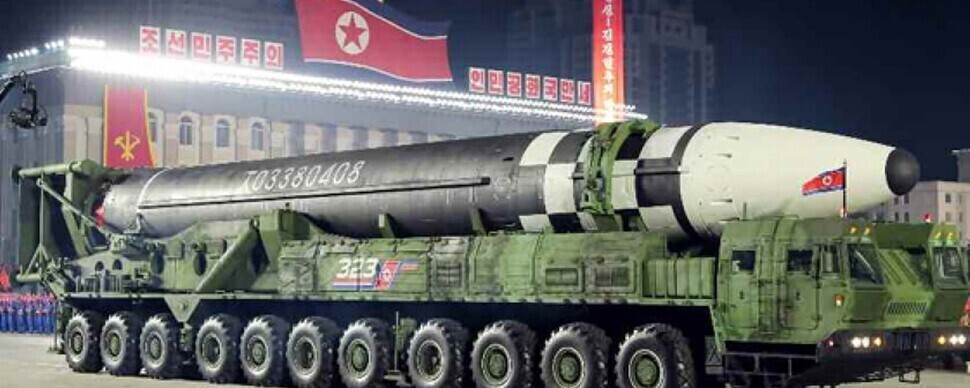hankyoreh
Links to other country sites 다른 나라 사이트 링크
Joint Chiefs: Likely ICBM launched by N. Korea exploded in air

North Korea test-launched what is believed to have been a new intercontinental ballistic missile on Wednesday, but the projectile exploded in midair shortly after its launch.
The South Korean Joint Chiefs of Staff (JCS) announced Wednesday that North Korea “launched a projectile from the area of Sunan near Pyongyang at 0930 on March 16, but it is believed to have failed shortly after launch.”
The projectile launch was North Korea’s 10th this year.
A South Korean military official said, “It appears to have failed in the early launch stage without achieving much of an altitude.”
Regarding the specifics of the projectile, the official said the matter would “require additional analysis.” It was reported that the projectile may have exploded at an altitude of less than 20 kilometers while ascending shortly after its launch.
Commenting on whether the projectile was a ballistic or cruise missile, the military official said it would be “difficult to determine based solely on the details detected so far.”
The projectile launch took place at Sunan airfield in Pyongyang, where North Korea recently conducted two performance tests of the new Hwasong-17 ICBM using a transporter erector launcher (TEL). South Korean military authorities are reportedly analyzing whether North Korea also launched a Hwasong-17 missile with its latest test.
Voice of America reported Tuesday that a large concrete structure had been detected at the Sunan airfield, citing civilian satellite photographs. Concrete structures are used in the firing of intermediate-range ballistic missiles (IRBM) and higher-range missiles from TELs to prevent the launcher from breaking and the missile’s trajectory from deviating.
On Sunday, a South Korean government official predicted that an additional missile launch by North Korea was “imminent.”
“We’re holding close discussions with the US on a response strategy,” the official said at the time.
If North Korea does launch another ICBM, South Korean and US authorities reportedly intend to respond militarily by ordering strategic bombers to the Korean Peninsula from a US Air Force base on Guam, while the South Korean armed forces conduct missile launch exercises.
On Tuesday, the US Indo-Pacific Command released photographs showing an F-35C fighter aircraft taking off from the USS Abraham Lincoln aircraft carrier in the Philippine Sea.
The command announced that the fighter had conducted a long-range flight as far as the West Sea. The same day, US Forces Korea announced that it was conducting exercises with a Patriot battery for intercepting North Korean missiles.
South Korean and US military authorities previously concluded that the two ballistic missiles test-launched by North Korean at the Sunan airfield on Feb. 27 and March 5 were medium-range ballistic missiles, with shorter ranges than an ICBM. But upon closer analysis, they concluded that North Korea had conducted performance testing with a Hwasong-17 fuselage.
North Korea has referred to its two missile launches as “important tests for reconnaissance satellite development.”
By Kwon Hyuk-chul, staff reporter
Please direct questions or comments to [english@hani.co.kr]

Editorial・opinion
![[Column] Tariffs on China: Trump was dumb, Biden dumber [Column] Tariffs on China: Trump was dumb, Biden dumber](https://flexible.img.hani.co.kr/flexible/normal/500/300/imgdb/original/2024/0520/191716191153918.jpg) [Column] Tariffs on China: Trump was dumb, Biden dumber
[Column] Tariffs on China: Trump was dumb, Biden dumber![[Column] What if Seoul took reunification by force off the table? [Column] What if Seoul took reunification by force off the table?](https://flexible.img.hani.co.kr/flexible/normal/500/300/imgdb/original/2024/0520/3017161928630494.jpg) [Column] What if Seoul took reunification by force off the table?
[Column] What if Seoul took reunification by force off the table?- [Editorial] Intensifying US-China rivalry means Seoul must address uncertainty with Beijing sooner than later
- [Column] When ‘fairness’ means hate and violence
- [Editorial] Yoon must stop abusing authority to shield himself from investigation
- [Column] US troop withdrawal from Korea could be the Acheson Line all over
- [Column] How to win back readers who’ve turned to YouTube for news
- [Column] Welcome to the president’s pity party
- [Editorial] Korea must respond firmly to Japan’s attempt to usurp Line
- [Editorial] Transfers of prosecutors investigating Korea’s first lady send chilling message
Most viewed articles
- 1Xi, Putin ‘oppose acts of military intimidation’ against N. Korea by US in joint statement
- 2Kim Jong-un wanted to meet with residents of shelled Yeonpyeong Island in South, Moon recalls in mem
- 3[Column] What if Seoul took reunification by force off the table?
- 4Berlin mayor hints at tearing down ‘comfort women’ memorial in city
- 5To weigh costs and benefits, Korea must stop treating US troop presence as a sacred cow
- 6[Editorial] Transfers of prosecutors investigating Korea’s first lady send chilling message
- 7[Exclusive] Truth commission to seek additional murder charges for figures behind 1980 Gwangju massa
- 8[Column] Tariffs on China: Trump was dumb, Biden dumber
- 9[Column] In Germany, Japan is waging a war over its history with Korea
- 10Top global investor predicts land of investment opportunities in unified Korea